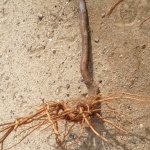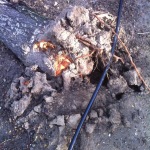The high wind from this past weeks storm has caused damage to orchards throughout the State. Trees have been blown over, uprooted from the strong winds, which will impact crop yields and orchard stand.
This damage usually can be categorized into two categories – trees that have blown over from a failed root system or from heart rot disease.
Failed Root Systems. Damage to almond trees from failed root systems tends to occur in younger orchards and is characterized by leaning trees within saturated soils. These trees “lean” because lateral structure roots were broken. In the worse case, trees may completely blow over – in which soil is still attached to the root system in an anvil shape. Most farmers often will pull these trees back into place and stake. This practice has variable results and it is important to consider why the tree has blown over compared to the surrounding trees. If there are structural issues with the root system, which include “J-rooting” from plantings, or disease, the tree should be replaced. Older trees most likely will have to be replaced.

Heart Rot Disease. This disease is one of the primary diseases affecting orchard decline. It is characterized by “dry rotted” or “cork-like” wood found in the center of the tree. These trees tend to be in their teens (13 years or older) and have incidence of crown gall or other trunk issues including shaker damage, previous Phytophthora canker, or broken scaffolds. After the wound occurs, a very large group of heart rot fungi, which typically degrade lignin, invade the heartwood of the tree, breaking down the plant’s tissues. Once enough of the tissue has been broken down, the tree loses structural integrity and falls over when enough force is received. It is thought that the initial infection of this group of diseases occurs relatively early in the tree’s life, but will take 5 or more years for the tree to blow over. More research needs to be conducted, but current recommended management practices must be in use throughout the entirety of the orchard’s life – with emphasis on the younger years.

Photo by M. Moran.
To prevent wind-throw and delay the tree losses to heart rot, practices must be applied at the layout and planting of the orchard. Avoid planting high on berms that are perpendicular to prevailing winds. Orient strong roots in the direction of the prevailing wind, and design the irrigation system to ensure a wetting pattern that will favor good root distribution. Avoid hard, dormant heading cuts on trees, which can favor a top-heavy tree as it creates multiple branching points. Select varieties that are less upright, and plan to defoliate the trees with zinc sulfate prior to any winter storms to reduce wind resistance. Avoid damaging tree trunks with tools and plant crown gall resistant rootstocks. Not much is known about crown gall resistant rootstocks at this time.
Being that this was the first major storm in a few years, tree loss was higher than normally expected. The impact of production will be dependent upon how many trees that were lost.


Ryan Williams
December 19, 2014Good article, I wanted to thank you for visiting my orchard this last Spring and looking at the preemergent issue. In this article you say that heading pruning cuts should be avoided. I would have thought that that would be the preferred pruning method. Heading cuts would shorten the tree and give the tree a lower center of gravity. The rejection of J root seedlings will be a welcome standard for me in the future.
David Doll
December 27, 2014Ryan,
Sorry for the delay in responding. I left for Christmas and am finally back in front of my computer.
The heading cut recommendation is tricky- it depends on timing, tree vigor, and how large the cut. If a vigorous tree is cut hard in dormant, the resulting vegetative growth will lead to upright, vegetative wood that will be prone to breakage. In contrast, a light summer tipping may reduce breakage. The former has been observed frequently, while the later needs more work to better understand the dynamics. My best thought at this time is the more vigor within a tree, the less dormant heading cuts, or “softer cuts” should be made.
I hope this aids in the clarification. You are welcome for the visit, please call anytime.
David
MARK BRADY
December 19, 2014Just the more reason the tree nut industry should embrace the protection of phosphite fungicides to protect the tree from both Phytophthora and Pythium. Phosphite fungicides provide the only economical curative and protective solution to address these issues. Without phosphites the tree nut industry yield losses could be substantial, not just from fallen trees, but also those standing trees with infected and suppressed root systems resulting in enormous yield drag. Whether a tree is standing or fallen, if it is severely infected with Phytopthora, Pythium, and wood cankers diseases such as Botryosphaeria, it cannot pull water and nutrient solution into the plant system and it’s going to fail to be profitable.
Currently several agencies and commodity groups are working to continue the availability of phosphites in the tree nut industry. I would encourage both growers and the crop protection industry to support these agencies and groups to the fullest.
Mark Brady
Western Marketing Manager
Plant Food Systems, Inc.
559 731-1267
mbrady@plantfoodsystems.com
David Doll
December 27, 2014Thanks Mark for sharing. The use of Phosphites have been shown to reduce root and crown rots of almond caused by Phythophthora and Pythium species. These do provide wounds in which other opportunistic pathogens then affect.
I agree, this is a great product and the industry and farmers must do what they can to protect the mode of action.
Bests,
David